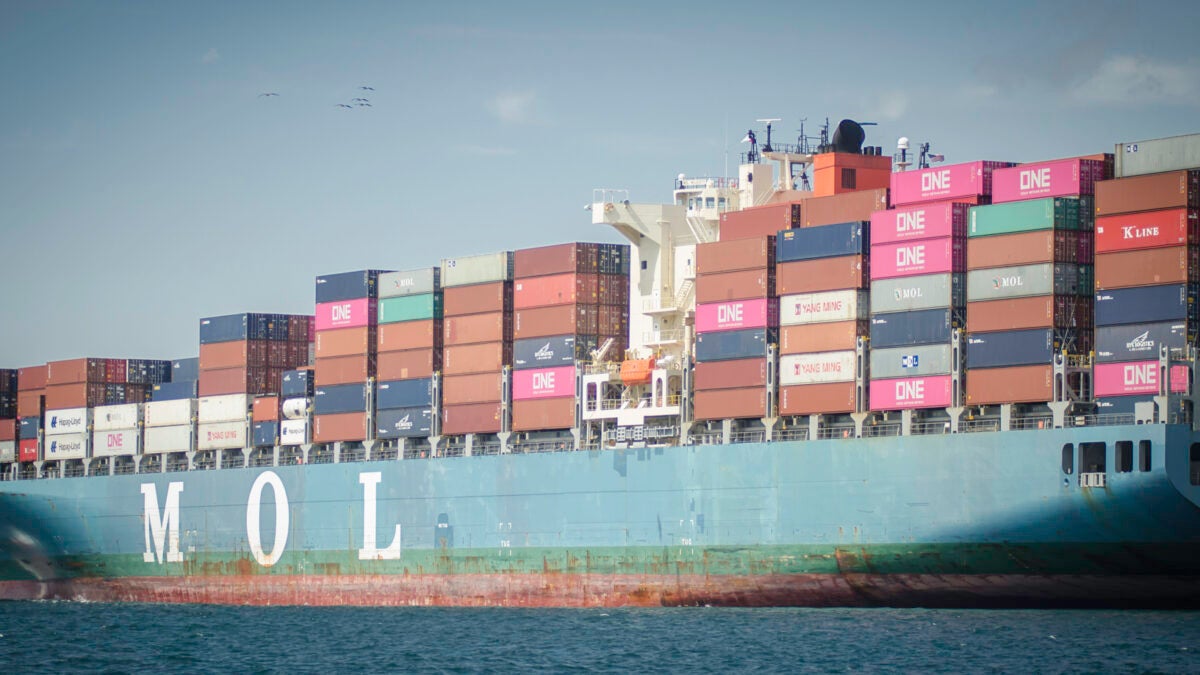“The U.S. has substantial strategic interests in the South China Sea, centered around maintaining freedom of navigation and enforcing international maritime norms,” Turker told FreightWaves in an email. “This is not just about economic stakes, but also about reinforcing the rules-based international order. Regular Freedom of Navigation Operations (FONOPs) are a clear expression of Washington’s intention to challenge China’s expansive claims. These operations are designed to assert that the waters in question remain open to all nations, according to the United Nations Convention on the Law of the Sea (UNCLOS) — even though the U.S. itself has not formally ratified the treaty.”
In August 2023, ships belonging to China and the Philippines accused each other of causing collisions in a disputed area of the South China Sea.
Philippine authorities said a Chinese Coast Guard ship carried out “dangerous blocking maneuvers” that caused it to collide with a Philippine vessel carrying supplies to troops, according to a statement on CNN.
In June, China and the Philippines blamed each other for causing a collision in the South China Sea near the contested Second Thomas Shoal, with the Philippines saying its armed forces would resist Beijing’s actions in the disputed waters, according to Reuters.
U.S. Ambassador to the Philippines MaryKay Carlson condemned China’s “aggressive, dangerous” maneuvers near the Second Thomas Shoal in a post on X in June.
In September, authorities in China and the Philippines agreed to a temporary deal after the countries had repeated collisions near the shoal. However, the Philippines said the deal might not be permanent.

The U.S. and the Philippines have a long history of cooperation, officially starting in 1951 with the U.S.-Philippines Mutual Defense Treaty. The treaty requires both nations to support each other if another party attacks either country.
“The likelihood of armed conflict in the South China Sea remains significant due to ongoing tensions, frequent confrontations, and increased militarization,” Turker said. “Incidents like the August 2023 underscore the persistent risk of military escalation. These confrontations reflect a broader pattern of assertive behavior by China, involving the deployment of coast guard vessels, maritime militia, and military assets to enforce its claims over disputed waters.”
Turker, a former commander in the Turkish navy, is the author “European Security and Defense Policy” (2007) and “Towards the New Cold War: Rising China, the U.S., and NATO,” (2019). He was also the academic coordinator and senior researcher at the Bosphorus Center for Asian Studies, an independent think tank based in Ankara, Turkey.
“Frequent incidents … demonstrate how easily low-intensity confrontations can occur, especially given the dense presence of military, coast guard, and civilian vessels in contested waters, which increases the likelihood of accidental or deliberate escalation,” Turker said. “This risk is compounded by China’s militarization of artificial islands, where airstrips, missile systems, and surveillance infrastructure have been constructed. These moves have prompted other claimants to bolster their defenses, leading to a more volatile environment.”
Turker said U.S. involvement would significantly escalate the situation in the South China Sea, particularly if military assets are deployed.
“This would not only raise tensions in the region, but could also lead to direct military confrontation with China — a scenario neither side desires, given the stakes involved. A U.S.-China conflict would have global repercussions, impacting trade, regional alliances, and the geopolitical balance of power. The specter of a broader war looms if such an incident escalates beyond a controlled, localized response, especially if U.S. allies like Japan or Australia are drawn in to support collective security efforts in the Indo-Pacific,” Turker said.
While a war breaking out in the South China Sea is a strong possibility, each country also has reasons for keeping the peace, he added.
“Several factors deter the escalation of limited skirmishes into a full-scale war in the South China Sea. The economic costs of a major conflict are substantial, as a war would disrupt critical trade routes, affecting global supply chains and damaging regional economies, including China’s, which heavily depends on maritime commerce,” Turker said. “Regional stability remains a priority for Southeast Asian nations, which, despite their assertive territorial claims, generally favor diplomatic solutions to maintain economic stability and avoid the risks associated with a prolonged conflict. The possibility of a broader confrontation involving major powers, such as the U.S. and its allies, is another significant deterrent. A full-scale war could draw these external actors into the conflict, raising the stakes to a regional or even global level, a scenario that all parties are keen to avoid.”
Wiegand said while she hopes there is a diplomatic solution to the territorial disputes in the South China Sea, it will be difficult to quell China’s rising ambitions.
“The problem is that the Philippines tried a diplomatic solution through the arbitration case, and China refused to even show up to the courts; they didn’t even send representatives,” Wiegand said. “Vietnam has tried negotiations multiple times, and China just refuses to back down, and they just keep repeating the same claim: These are our territories, these are our waters. There’s only so much you can do diplomatically. For the other countries, they’re kind of stuck until China makes a move. It’s really at a standstill right now, and unfortunately, I think the status quo is just going to be a continuation of China maintaining its claims, maintaining the control of the islands, controlling the waters. It’s really up to the other disputing countries, whether they want to really pressure China any further to try to overturn that status quo. That’s a very difficult thing to do diplomatically.”
By Noi Mahoney.

![Disputes in South China Sea could disrupt trade lanes, lead to war, experts say [Part 1 of 2]](https://www.minelog.com.my/wp-content/uploads/2024/11/20241103-ML01-1024x576.jpg)
